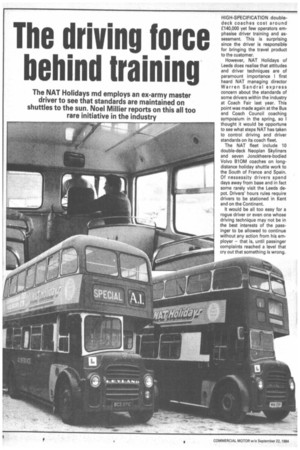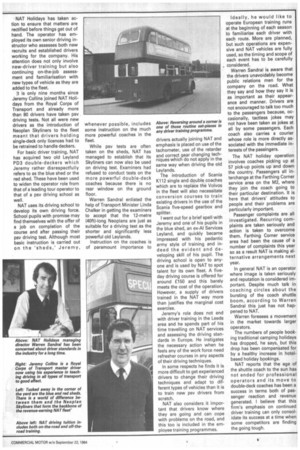The driving force behind trainin
Page 50

Page 51

If you've noticed an error in this article please click here to report it so we can fix it.
The NAT Holidays md employs an ex-army master driver to see that standards are maintained on shuttles to the sun. Noel Millier reports on this all too rare initiative in the industry
HIGH-SPECIFICATION doubledeck coaches cost around £140,000 yet few operators emphasise driver training and assessment. This is surprising since the driver is responsible for bringing the travel product to the customer.
However, NAT Holidays of Leeds does realise that attitudes and driver techniques are of paramount importance I first heard NAT managing director Warren Sandral express concern about the standards of some drivers within the industry at Coach Fair last year. This point was made again at the Bus and Coach Council coaching symposium in the spring, so I thought it would be opportune to see what steps NAT has taken to control driving and driver standards on its coach fleet.
The NAT fleet include 10 double-deck Neoplan Skyliners and seven Jonckheere-bodied Volvo B1OM coaches on longdistance holiday shuttle work to the South of France and Spain. Of nessessity drivers spend days away from base and in fact some rarely visit the Leeds depot. Drivers' hours rules require drivers to be stationed in Kent and on the Continent.
It would be all too easy for a rogue driver or even one whose driving technique may not be in the best interests of the passinger to be allowed to continue without any action from his employer — that is, until passinger complaints reached a level that cry out that something is wrong. NAT Holidays has taken action to ensure that matters are rectified before things get out of hand. The operator has employed its own senior driving instructor who assesses both new recruits and established drivers working for the company. His attention does not only involve new-driver training but also continuing on-the-job assessment and familiarisation with new types of vehicle as they are added to the fleet.
is only nine months since Jeremy Collins joined NAT Holidays from the Royal Corps of Transport and already more than 80 drivers have taken psv driving tests. Not all were new drivers as the introduction of Neoplan Skyliners to the fleet meant that drivers holding single-deck only licences had to be retrained to handle deckers.
For basic driver training, NAT has acquired two old Leyland PD3 double-deckers which Jeremy rather disrespectfully refers to as the blue shed or the red shed. These have been used to widen the operator role from that of a leading tour operator to that of a psv driving school as well.
NAT uses its driving school to develop its own driving force. School pupils with promise may find themselves with the offer of a job on completion of the course and after passing their psv driving test. Although most basic instruction is carried out on the 'sheds,' Jeremy, whenever possible, includes some instruction on the much more powerful coaches in the fleet.
While psv tests are often taken on the sheds, NAT has managed to establish that its Skyliners can now also be used on driving test. Examiners had refused to conduct tests on the more powerful double-deck coaches because there is no rear window on the ground floor.
Warren Sandral enlisted the help of Transport Minister Linda Chalker in getting the examiners to accept that the 12-metre (40ft)-long Neoplans are just as suitable for a driving test as the shorter and significantly less powerful old Leylands.
Instruction on the coaches is of paramount importance to drivers actually joining NAT and emphasis is placed on use of the tachometer, use of the retarder and correct gear changing techniques which do not apply in the same way when driving the old Leylands.
The introduction of Scania K112 single and double coaches which are to replace the Volvos in the fleet will also necessitate conversion courses to train existing drivers in the use of the Scania five-speed gearbox and splitter.
I went out for a brief spell with Jeremy and one of his pupils in the blue shed, an ex-Al Services Leyland, and quickly became impressed with his pedantic army style of training and indeed the evident and developing skill of his pupil. The driving school is open to anyone and is used by NAT to spot talent for its own fleet. A fiveday driving course is offered for around £150 and this barely meets the cost of the operation. However, a supply of drivers trained in the NAT way more than justifies the marginal cost exercise.
Jeremy's role does not end with driver training in the Leeds area and he spends part of his time travelling on NAT services and assessing the driving standards in Europe. He instigates the necessary action when he feels any of the work force need refresher courses in any aspects of their driving techniques.
In some respects he finds it is more difficult to get experienced drivers to change their driving techniques and adapt to different types of vehicles than it is to train new psv drivers from scratch.
NAT also considers it important that drivers know where they are going and can cope with problems on the road, and this too is included in the employee training programmes. Ideally, he would like to operate European training runs at the beginning of each season to familiarise each driver with each route. More are planned, but such operations are expensive and NAT vehicles are fully used, so the timing and scope of each event has to be carefully considered.
Warren Sandral is aware that the drivers unavoidably become public relations men for the company on the road. What they say and how they say it is as important as their appearance and manner. Drivers are not encouraged to talk too much to the passengers because, occasionally, tactless jokes may not have been taken as jokes at all by some passengers. Each coach also carries a courier whose role is more directly associated with the immediate interests of the passingers.
The NAT holiday operation involves coaches picking up at 57 pick-up points up and down the country. Passengers all interchange at the Farthing Corner service area on the M2, where they join the coach going to their particular destination. It is here that drivers' attitudes to people and their problems are particularly important.
Passenger complaints are all investigated. Recurring complaints are taken seriously and action is taken to overcome them. Farthing Corner service area had been the cause of a number of complaints this year so as a result NAT is making alternative arrangements next year.
In general NAT is an operator where image is taken seriously and reputation is considered important. Despite much talk in coaching circles about the bursting of the coach shuttle boom, according to Warren Sandral this just has not happened to NAT.
Warren foresees a movement in the market towards larger operators.
The numbers of people booking traditional camping holidays has dropped, he says, but this drop has been compensated for by a healthy increase in hotelbased holiday bookings.
NAT reports that the age of the shuttle coach to the sun has not ended for professional operators and its move to double-deck coaches has been a success in terms both of passenger reaction and revenue generated. I believe that this firm's emphasis on continued driver training can only consolidate its success at a time when some competitors are finding the going tough.




























































































